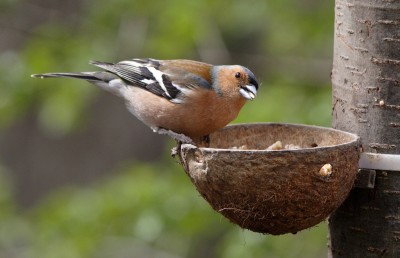- Home
- FAQs
- Customer Video Gallery
- Customer Photo Gallery
- Bird Facts
- Bird Food Blog
- Bird Information
- Feeding Advice
- Small Animal Information
- A to Z of Guinea Pigs
- A to Z of Hamsters
- A to Z of Rabbits
- Basic Care for Guinea Pigs
- Basic Care for Hamsters
- Basic Care for Rabbits
- Basic care for Chinchillas
- Basic care for Ferrets
- Basic care for Gerbils
- Basic care for Mice
- Basic care for Rats
- Buying a Healthy Small Animal
- Does your Reptile need a Licence
- Equipment for Ferrets
- Equipment for Hamsters
- Equipment for Mice
- Equipment for your Chinchilla
- Equipment for your Gerbil
- Equipment for your Guinea Pig
- Equipment for your Rabbit
- Keeping a House Rabbit
- Dog Information
- Cat Information
- Customer Information
- Fat Balls
- Suet Pellets
- Straights
- Seed Mixes
- Suet Treats
- Mealworms
- Bird Feeders
- My Account
Let the feast begin
Date: 2012-11-01 16:28:58 | Category: Bird Feeding | Author: Twootz Staff
Attracting birds to your garden is very easy and can be done by simply putting out food and water - it's well worth it.As your little feathered friends come and go, singly, in pairs or small flocks, and you watch their antics, their habits, their relationships with their own kind and with other bird species, you build an informal knowledge about the wildlife in your area.

At first it may be a little slow, but somehow the word gets round the local bird community and you will be greeted by the occasional visit from some of the less common species.
During the colder weather, when birds find it difficult to find enough food to maintain their small bodies, flying is very hard work! Thus it is best to provide a hi-energy food source such as Suet Crumbles.
Suet Crumbles are a cheap, versatile option for bird feeding and an ideal way to enthuse children about wildlife - the uses are only limited by your imagination.

Thrushes, Blackbirds and Dunnocks prefer to feed on the ground - for these birds, scatter Suet Crumbles on the lawn or use a ground feeding tray or hopper well clear of cover to avoid lurking cats
For agile birds, such as tits, woodpeckers, and wrens it can also be mixed with other bird food; such as seeds, and pushed into holes and cracks in poles or even into hollows in logs to help stimulate and challenge birds during feeding.
The whole or partially formed balls can also be hung from trees or placed in fat ball feeders around the garden creating many different feeding areas and thus very happy birds.
Try to space out the feeding areas into different zones around the garden to reduce competition between birds so that more birds can feed at any one time. Ensure there is a supply of clean, fresh water for both drinking and bathing to help our feathered friends stay fit and healthy.
Please note: never put out any food in mesh bags as these may trap birds' feet. Birds with a barbed tongue, e.g. woodpeckers, can become trapped by their beaks.




